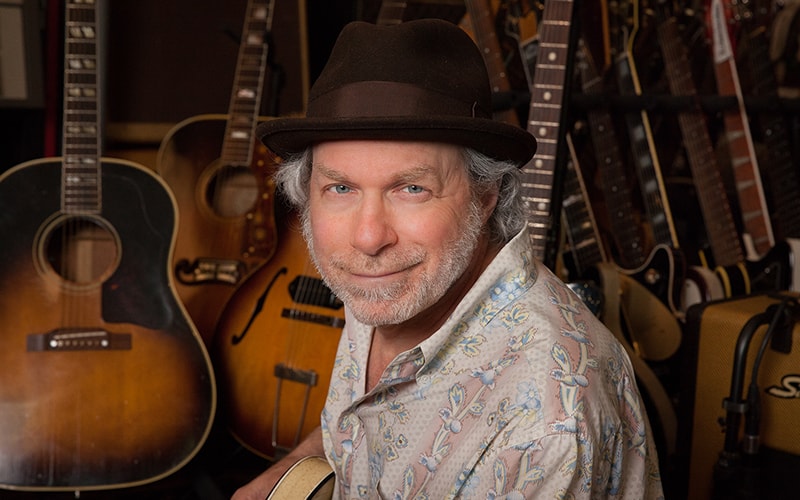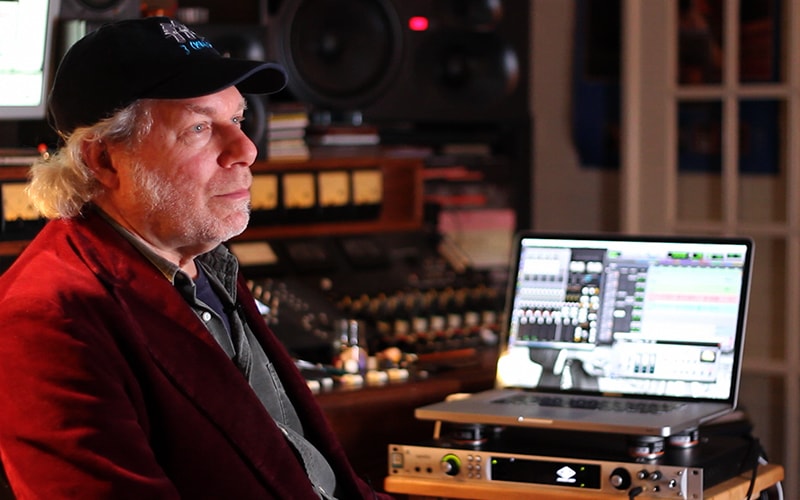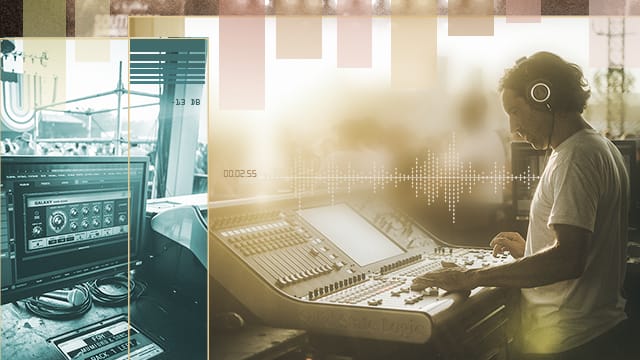
Nashville’s Lean, Mean, Session Machine
Buddy Miller on Making Records with Apollo and UAD‑2 Plug‑Ins
Robert Plant has a pretty good track record with the guitarists who accompany him, so when he tapped longtime Nashville multi-talent Buddy Miller to be the musical director, guitarist, and co-producer for his Band of Joy project, he no doubt knew the vast expertise Miller brought to the table.
Whether through the records he’s written and produced with his wife, Julie Miller, or with fellow producer/writer Jim Lauderdale, or via his sideman/production gigs with legends like Emmylou Harris, Miller has remained one of Nashville’s true believers, ably side-stepping the trendier aspects of pop-country while focusing on the artists who’ve earned his respect and affection.
Miller, currently the Executive Music Producer of the hit show that bears his adopted town’s name—the top-rated Nashville—is no stranger to wearing different musical hats. Here, he discusses his extraordinary juggling act, and how UAD Powered Plug-Ins, like the Ocean Way Studios Plug-In, help his creative process
How did you come by the Nashville music producer gig, and what are the challenges to that job?
Callie Khouri called me to produce a few songs for the ABC Nashville pilot, and when the show got picked up T Bone Burnett became the season one executive music producer. There is no one better than T Bone. I got to know him while playing guitar on the Raising Sand tour with Robert Plant and Alison Krauss. Subsequently, he called me to play guitar on several projects he was producing.
While working with T Bone on the show, I ended up producing or co-producing 20 to 30 songs for that first season. I learned so much being around him and found out the many and varied needs of a music driven TV show. Season two, T Bone stepped away and they offered me the Executive Music Producer position. It involves a lot more than producing and playing — it also involves helping pick the songs, matching songs to script and individual characters, working with the cast on their vocals, and recruiting outside producers to create a varied-but-unified sound. We usually record three versions of each song. It is a lot of work, but it helps that the cast and everyone working on the show are really talented people.
What’s the through-line with balancing all these different hats — just a big set of ears?
Yeah, I think that’s part of it, and it helps that I’m old! Music is the only thing I’ve ever done since I was a teenager. For me, it’s never been about just one genre or one hat. I love almost every kind of music, and I’ve played every instrument I could get my hands on. I’ve always been intrigued by recording and producing. I had a reel to reel-to-reel recorder when I was 10 years old!
I grew up in the ’60s when radio was wide open and played mixed formats, it was a wild time for music, and rock was inventing itself. I went to Woodstock one weekend, and a bluegrass festival the next. Musicians were creative beyond words. But I think it’s a fertile time for new music right now too — there are so many inspiring songwriters and new bands. Working on ABC’s Nashville show has put many of them in front of me. Also, after all these years, my ears are fine tuned so I know a great song when I hear it.
"I used to agonize over mic preamps, but I don’t have to do that anymore because the Apollo mic preamps sound really good."
You’ve done a pretty immense amount of writing yourself.
Yeah, My wife is more of the writer in the family, and yes, we’ve had success with writing. But our output is small by the standards of this town. Nashville is unique in the world. It’s like the Brill Building spread out over an entire city — there’s an energy here. You’re talking about hundreds and hundreds of full-time songwriters. I can’t even imagine how many songs are being turned in every single day, some are crap, but a lot of them are really good.
You do most of your records at your house, is that right?
Yeah — most records I’ve made, and continue to make, I’ve done here at my home studio. At first it was because I couldn’t afford to work in a studio, and I wanted to work all through the night, then I began to love the sound of my house and learn some of its secrets. I produced Shawn Colvin’s last record here, and Richard Thompson’s last one, Solomon Burke made one, and we made a Robert Plant record here that might see the light someday. But the truth is, wherever I record, I use Universal Audio plug-ins. I use my favorite UAD plug-ins on every project.
It’s funny, I have a lot of the original hardware that the UAD plug-ins are based on, and the plugs really do sound great — even compared to the hardware.
I moved to Nashville over 20 years ago with a Studer A80 2” recorder, now I’ve got a Fatso, old Urei 1176s, and the new reissues, a Fairchild 670, DBX 160’s, BAE1073’s, an LA-2A, the Manley Massive Passive, and I’ve even got a nice plate reverb in my basement. My console is an old ’70s Trident B-Range 28x24-channel console.
And even with all this analog gear, the plug-ins are still amazing to me. They just sound great, they really do. So even though I have a 2” machine and a 1/2" machine, I find myself using the Studer A800 Multichannel Tape Recorder plug-in and the Ampex ATR-102 Mastering Tape Recorder plug-in a lot.
You’re a fan of ambient recording. Are there any particular plug-ins that lend themselves to that?
Well, the Ocean Way Studios Plug-In kills me. Yes, I’m a big fan of ambient recording, and I love the sound of rooms. To me, when I make recordings in my house, I like that it sounds like a house and I always use room mics. Bleed is my friend. I might have guitar amps in the room with the drums, and drums in the room with the singer. You just need to have great players, and singers that can really sing.
I’ll sometimes have my singer in the same room with the drummer if it’ll get a better performance. I’ve had Jay Bellerose or Marco Giovino in the room, with the singer about 12-feet from the drummer — and that’s without gobos or baffles around them — just singing in the room. And they sound like real recordings of a great performance, and isn’t that the goal?
That can make mixing a bit tricky, of course.
Y’know, if you get a great vocal take, you’re most of the way there. Sure, bleed can complicate the mixing, but it also adds something real to it. Upright bass is the trickiest for me to mix if it’s in the room. That’s the instrument I might isolate if possible. I like having a ton of low-end in the upright sound, and that can be hard to preserve.
Still, I’ll use the Ocean Way Studios Plug-In on tracks, including vocals. My room doesn’t always provide the sound I’m going for, so I look for ways to embellish: I might put up a pair of ribbon mics and smash them through a couple compressors, having the compression bring out things in the room sound that you normally wouldn’t hear. Mic placement and certain pieces of gear can help you do that, but the Ocean Way Studios plug-in is amazing for that.
Are there any other applications you might use the Ocean Way Studios Plug-In for?
Jim Lauderdale and I have a weekly radio show on Sirius XM — The Buddy & Jim Show. This town is home to so many deep songwriters and artists, many of whom are my heroes, I thought let’s do a show and have a guest every week, to sing a little bit, play old records, and then we’ll talk about music. So when they play, I add a little of that Ocean Way Studios Plug-In, to imply that it’s a nicer room than the one we’re actually in.
I feel like I hear the EMT® 140 Classic Plate Reverberator plug-in on some of your recordings, too.
I do use the EMT-140 Plate Reverb Plug-In a lot, which is funny, considering that I have a very nice real huge plate reverb in the basement, just below my console — except that sometimes I think I hear mice walking on my plate. You definitely do not have mice walking on the plug-in version, and the plug-in gets me most of the way there!
I understand you’ve also been using the Apollo 16 interface quite a bit.
There’s this cruise from Miami to St. Barts and St. Croix — but it’s not your typical party boat. It’s called Cayamo, and it involves probably 30 to 40 artists, all roots music; people like Lyle Lovett, John Prine and Bruce Hornsby, Ricky Skaggs and Lucinda Williams. We had Kris Kristofferson last year, and Brandi Carlile. Well, loving collaborative moments as much as I do, I realized that I was missing an opportunity to record some incredible moments. I decided to bring an engineer, a bunch of mics, and a recording rig onto the boat to make a record. And that’s what I did.
The Cayamo staff let me bring Gordon Hammond to engineer, and we brought in an Apollo 16. They gave us the ship’s bowling alley to use as our studio — it's the vibiest room on the boat. And I recorded collaborations with Kris Kristofferson, The Lone Bellow and Brandy Carlisle, Lee Ann Womack, and many others. I used the Apollo 16 throughout, and of course mixed it using UAD plug-ins and it sounds really great. In fact, I use the Apollo 16 for all of my location recording.
"Even though I have a Studer two-inch tape machine, I find myself using the Studer A800 and the Ampex ATR-102 plug-ins a lot."
Can you go into more detail about your workflow with the Apollo 16 on the Cayamo cruise?
Pardon the pun, but it was a lifesaver! Being able to use the UAD plug-ins while you’re tracking, and being able to get good rough mixes real fast — I mean everything moves more quickly because of that.
We had a rack with 16 outboard mic pres, and with the Apollo 16 that’s all we needed — it’s portable, has as many inputs as you need to make a record, and instantly sounds right. We used all 16 inputs, and not only were we able to set up a kind of mini studio in the bowling alley on the boat, but with DB25 cabling, we could break down the system really quickly and set up in the theater for live recording the same night. Then bring it back to the bowling alley, and with our cue system working through Apollo’s Console application, we would listen to playback right off the Apollo 16. It was really easy to get rough mixes up right there on the boat in our makeshift studio.
When I’m engineering, it’s so fast and furious, I’m not finessing anything. What I’m concerned about is if there are headphones — and half the time there aren’t, because I also love to record without headphones — but if we are using headphones, I want them to sound as beautiful as possible for the musicians and singers, because that’s how you get their best.
Other than that, it’s about helping players get comfortable — not thinking about “making a record”, just playing music and capturing the performance to tape — or whatever it is now!
You also own an Apollo QUAD interface. In what capacity do you use it?
I use the Apollo QUAD quite a bit when I’m doing my radio show, almost in a field recording capacity, and that small format with the four inputs is perfect for me. And I will say that the mic preamps on it are great. I don’t think twice about using them for anything at any time. I used to agonize over mic preamps, but I don’t anymore because the Apollo mic preamps sound really good.
You’re someone whose higher profile work happened a bit later in life. How did you stay strong in the business even during the leaner times?
Well, maybe because I was able to do a lot of things — none of them all that great — but a lot of things. I was able to juggle and somehow pay the bills. Doing everything from playing sessions to singing jingles, writing songs, engineering, producing, and touring as an artist or sideman. I’ve always felt that if I can make music and pay the bills, that’s the goal — everything else is gravy overflow. I grew up living in broke hippie band houses, with ten guys and ten dogs, playing six nights a week, living pretty lean. Eventually, you just figure out how to make things work. And these days I love everything I do, that’s a prerequisite: if it’s not fun, I don’t do it. Life is too short. It’s been an amazing run.
Buddy Miller Photos: CJ Hicks
— James Rotondi
-
On Sale
EMT® 140 Classic Plate Reverberator
Add to CartRegular Price: $199.00
$49.00
You'll Save 75%
Read More
The Human Element
Learn how SOHN (aka TophTaylor), uses UAD plug-ins and his Apollo x8p interface for his ultra-textured laptop symphonies and how he learned to embrace the human element in his recordings.
Mumford & Sons on the Road with UAD-2 Live Rack
Mumford & Sons FOH engineer Chris Pollard details how he uses UAD-2 Live Rack and UAD plug-ins to shape the chart-topping group's string of sold-out shows.
Fab Dupont on Capturing Island Vibes with Monsieur Periné
Producer/engineer Fab Dupont (Jenifer Lopez, David Crosby) details his Apollo Artist Session with Monsieur Periné on the remote island of Providencia, Colombia, and how he used Apollo X and Twin interfaces for album quality results.





